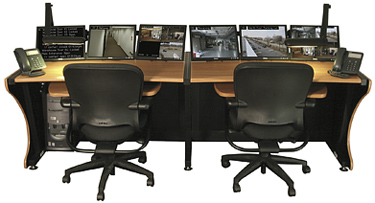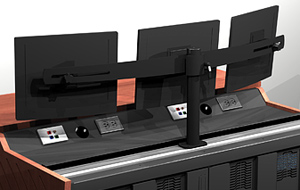Future-proofing Studio Furniture
There was a time when a studio control room was designed around equipment, like switchers, character generators, etc., that could be expected to last for quite a few years. Job functions, director, TD and audio operator, also remained the same, and so would the home for people and equipment: a custom-designed and cut console.
"In the past, the half-life of a typical monolithic wood or steel console was about five years," said Jerry Hahn, president of TBC Consoles, an Edgewood, N.Y.-based provider of technical furniture systems. "We spent a lot of time and effort customizing our consoles to each facility's exact requirements. We cut every piece of equipment perfectly into the countertop or splash/turret panel."
FLEXIBLE CONFIGURATIONS
The price for this process, however was that as equipment upgrades were required, console modifications were difficult, expensive or impossible. When a new round of equipment was finally purchased, and a new console ordered, the old console might have to be cut up with a Sawszall or an acetylene torch just to get it out of the room.

Middle Atlantic Product's LD Series desk Over the past 5 years, several console companies have developed modular console systems that anticipate inevitable technological changes. The ease of console modifications due to equipment or operational upgrades more than makes up for the momentary perfection of complete customization.
Today, with so much equipment evolving year to year, with new and different flat screen monitoring requirements, and with job functions being consolidated under fewer and fewer production crew members, customers have insisted on "future-proofed" studio consoles, flexibly configurable units that can evolve, inexpensively, as the broadcasting industry evolves. Modular is the name of the game.
Bill Haberman, president of Forecast Consoles in Deer Park, N.Y., compared the way his company has designed its consoles to the way department store mannequins are built. "Basically the skeletons are the same, the parts are the same. There are different sizes and they're dressed differently. I can take Forecast's MASTERail console and I can make it a straight console, a curved console, angled, full circle, anything I want just by adding pre-engineered components to it."
Dave Amoscato, broadcast sales director for Middle Atlantic Products in Fairfield, N.J., said, "We've developed configurable furniture where we make modules or units up that can stand alone, and then we can keep on adding options. Whether it's rack units, or cooling, or wire cabinets, we've always designed with systems in mind."
As much as any other component in a broadcasting facility, video monitors have evolved, making the change from CRTs to flat panel screens, and then from 4:3 to 16:9. Randy Smith, president of Winsted, a production console manufacturer in Minneapolis, touts the company's flexibility in this area.
"The magic of our console is an aluminum extrusion rail in the back that allows you to adjust the poles that hold the LCDs, and you can attach 1, 2 or 3 LCDs side by side, so if you go to the larger format, all you have to do is widen them apart," Smith said. "So the parts aren't obsolete. Our consoles are modular and adjustable to expand for your future needs."
TBC's Intellitrac console system offers above counter rack turrets that are within ergonomic reach of the operator and may be positioned anywhere along the length of the console. "The turret is easily removable or replaceable when equipment changes, offering an adaptable advantage towards non-obsolescence and re-use," said TBC's Hahn.
Winsted provides beefed up doors to the equipment storage space below the console. "We place the CPUs on the door, the door is rigid enough, and we have a shelf for wire management in the back," said Winsted's Smith. "When you swing the door open, the drives are facing you and you have access to the back of the CPU for wiring changes."

Winsted's Sightline DeskCUSTOM MADE OR DIY
When it comes to designing and modifying their consoles, customers can do it on their own or ask the console maker for help. "Some customers know exactly what they want," said Middle Atlantic's Amoscato. "Others look to us for a little assistance on how to migrate to their new installation." His company supplies RackTools' free layout and specification software that provides users with a drag-and-drop interface to create accurate rack elevation and plan view drawings.
Eventually, of course, even the most configurable studio console—one that has been used over and over again—is going to come to the end of its useful life. In line with "going green," console makers have also been thinking about using materials that are recyclable and reusable.
"Metals and plastics like polyethylene and other plastics are renewable resources in the sense that they are reusable," said Forecast's Haberman. "They can be melted down and made into something else. So we've basically stopped using particle board and other materials that you throw away. The only part not like that is the plywood we use as a substrate for the countertop. I would say that 95-percent of the rest of the console is reusable."
The traits of the studio console of yesteryear were beauty and functionality. Today, console makers have had to add modularity, flexibility and configurability to the mix.
The professional video industry's #1 source for news, trends and product and tech information. Sign up below.
